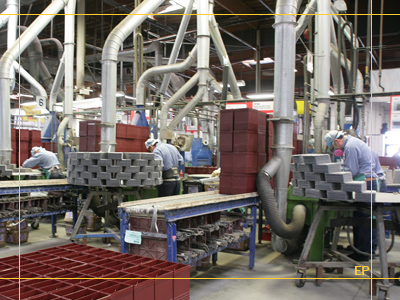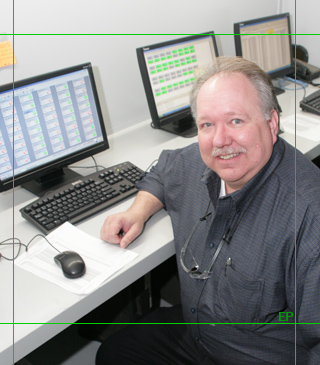September 2007
![]()
AutomatedBuildings.com
[an error occurred while processing this directive]
(Click Message to Learn More)
September 2007 |
[an error occurred while processing this directive] |
|
|
Denis DuBois Case Study |
ABSTRACT
Trojan Battery Company made record-setting investments in technologies that
essentially enable them to buy less energy from their utility. What's unusual
about that? The utility paid for the technology, and pays Trojan Battery to use
it. The process of preparing for summer demand response yielded a fortunate
financial byproduct: Trojan gets lower rates that are saving the company
thousands on its electric bill every month.
Shakespeare wrote, "Misery acquaints a man with strange bedfellows." Crises of all kinds forge unexpected alliances, and the current energy situation is no exception.
|
|
|
|
|
|
|
|
|
|
|
|
|
|
|
|
|
|
|
|
|
[an error occurred while processing this directive] |
Utilities are in the business of selling electricity. The source of Southern California Edison's misery is the prospect of not being able to deliver enough power to meet a peak demand. It's important to understand this (and to grasp the basics of demand response) to comprehend their seemingly strange alliance with one customer, Trojan Battery Company of Santa Fe Springs, California.
How a manufacturer tackled a $5 million electric bill
Trojan Battery manufactures deep cycle batteries. Their products are well known among off-grid renewable energy users, especially in South America and the Caribbean. Here in the U.S., Trojan is known for its batteries for golf cars, recreational vehicles, marine, renewable energy and industrial applications. Their name is inseparably linked with energy.
Trojan wanted to participate in a demand response program with their utility, Southern California Edison. The revenue from the program could offset part of Trojan's multi-million dollar energy bill.
Unlike typical office buildings, manufacturing facilities are complex when it comes to shedding loads without adversely affecting production. In its initial consultations with energy efficiency experts, Trojan was hearing the usual advice about raising thermostats or dimming lights. Their situation was not that simple.
"Controlling lighting was a no-brainer," says Chad Bentley, Trojan's Manager of Manufacturing Technology. "But forming batteries is by far our largest load."
Forming batteries is the process of charging a battery for the first time. Trojan has 700 circuits of rectifiers, each connected to batches of new batteries. Thousands of batteries are in this electrochemical process at any given time.
Each batch has its own forming requirements based on the battery type. Some require 26 hours of formation, while others need as much as 100 hours. The power levels are carefully regulated throughout the cycles. The time and regulation, called the battery's formation profile, have been perfected over many years for optimum battery life and performance.
The forming process is energy intensive and mission critical. It represents 60 percent of Trojan's four-megawatt load. But interrupting it can ruin hundreds of new batteries. Simply turning off the equipment for demand response was not an option. The legacy machinery was not equipped with interfaces for more granular control, so it looked as though the process would be left out of the loads to be shed for demand response.

In Trojan Battery Company's manufacturing plants, the largest loads aren't lighting or HVAC. To really make a difference in a plant's energy consumption took ingenuity and perseverance.
(Photo courtesy of Trojan Battery Company)
Perseverance pays
Trojan has been in business since 1925, and the founding family's fourth generation is working its way up through the ranks. Patience and persistence are part of the company's culture. Chad Bentley continued to search for the answer.

Chad Bentley, Trojan Battery's Manager of Manufacturing Technology, sits at the company's demand response control center. With a few keystrokes, he can shed 3,400 kW -- almost completely shutting down the plant's complex operations -- in under 15 minutes, without leaving his seat.
(Photo courtesy of Trojan Battery Company)
After months of talking with the manufacturers of the forming equipment, he struck on the solution.
"The forming process can't be interrupted, but for many battery types it can be slowed or paused, Bentley explains. "The manufacturers began to cooperate with us to interface their forming equipment with centralized controls." With Trojan's tight parameters, how much flexibility could they exercise to reduce electricity consumption on demand?
Bentley set to work defining the latitude in each formation profile. With some battery types he could reduce the power, and compensate by prolonging the formation. Others could withstand being taken off formation for a few hours, with no adverse effects on quality.
The concept was validated by Trojan's energy advisors at a local university and the U.S. Department of Energy. Centralized control of formation would allow Trojan to shed a significant portion of their loads on short notice.
Plant can shut down on command
In each of Trojan's manufacturing plants are several other pieces of equipment that could be controlled to shed loads. Trojan chose Powerit Solutions in Seattle WA to provide the software and hardware to control air compressors, chillers, forklift chargers and dust-control equipment in two plant locations.
Energy Director, the Powerit Solutions application, allows Trojan's plant operators to monitor and control the equipment from any networked PC. Energy Director and its network of devices are integrated with Bentley's formation control system.
"Powerit Solutions is an integral piece of the system," Bentley explains. "We now schedule, control loads, and shut them down, without running around the plant."
Trojan can shed as much as 3,400 kilowatts on demand, 85 percent of their average total load.
[an error occurred while processing this directive] Utility paid for the systems
According to Bentley, the centralized formation control system represents about 60 percent of the newly controlled load, and the cost was between $500,000 and $600,000.
Powerit Solutions' Energy Director and related networking gear represents another 30 percent of the controlled load. The system cost was about $75,000, and was cost-justified on its own merits -- it qualified Trojan for lower electric rates available to utility customers who can shed loads on short notice.
"With a few keystrokes we can turn off loads throughout the facility within minutes," says Bentley. "We were able to take advantage of the 15-minute interruptible tariff, which saves us about $90,000 a year on electricity, because we’re able to respond quicker."
As it turned out, Energy Director wouldn't have to be cost justified, nor would the formation control investment. Bentley took advantage of an incentive program offered by SCE to install technologies that would help Trojan participate in demand response.
"SCE paid for practically the whole system, and would have paid for more," Bentley says. The utility wrote a check to Trojan Battery for $576,627, the single largest rebate under SCE’s Technical Assistance and Technology Incentives Program. The TA&TI program provides financial incentives for the installation of technologies that reduce electricity use during high-demand periods. Trojan's formation controls might also qualify for SCE efficiency rebates worth another $160,000.
"We were able to take advantage of the 15-minute interruptible tariff, which saves us about $90,000 a year on electricity, because we’re able to respond quicker."
--Chad Bentley, Trojan Battery Company.
Measurable success for Trojan Battery
"We've already realized that our formation process improved, and that will extend product life and help the environment," says Bentley. "And we anticipate saving 15 percent on our largest electric load."
Trojan expects a financial payback in six to twelve months, even without utility payments from a demand response call. With the same system, the company qualifies for interruptible electric rates. Trojan pays less per kWh, with the understanding that its power can be shut off on short notice.
"We were on the 30-minute tariff," Bentley explains, "but this system lets us turn off the whole facility in under 15 minutes, with a few keystrokes." That ability qualifies Trojan for a 15-minute interruptible tariff. "The lower tariff saves us around $90,0000 a year on energy costs," notes Bentley.
Shutting down the entire facility is not likely to be necessary any time soon. According to Trojan, SCE imposed one involuntary interruption under the 30-minute tariff last year, and is building up its demand response programs to achieve higher levels of voluntary load shedding.
Revenue on demand
Energy Director and the centralized formation control are installed and responding to demand response calls from SCE. Trojan has the flexibility of answering the calls when they want to. The company bids for a number of kW to shed, when, and for how long. Then they plan for that curtailment event.
[an error occurred while processing this directive] "In June and July we earned more than $30,000 for demand response events," Bentley reports. "We utilized less than 20 percent of our available opportunity in those nine events -- we dispatched over 60,000 kWh using just the formation rectifier control systems. We had to limit our participation because the plant has been extremely busy."
Summer is just getting started, and Bentley expects to achieve even greater savings in the hot months of August and September, "potentially $10,000 on a single event for the main facility."
According to Trojan, SCE pays $0.50 per kW of load that is shed. Participants who shed within 50 percent of their bid are paid for the full number of kW they bid. "SCE wants a committed load reduction, and they pay for it," Bentley adds.
It's an investment that pays off for Trojan, SCE, and other utility customers, says Bob Zak, president of Powerit Solutions.
"The beauty of coordinating automation with utility demand response is that everyone on the grid also wins," Zak explains. SCE can postpone much larger investments in infrastructure to meet peak demand, if that demand's growth flattens.
Slowing production is good for the electric bill, the grid and the environment, but what about the impact on plant output?
"There's no net impact on production," says Bentley. "Over the course of a week, we can respond two times and still stay on target for production." That's because production doesn't stop, it just slows, during demand response calls. "When the right automation technology is applied to these demand challenges, it provides the end user with the perfect mix of increased control and decreased cost,” says Powerit's Bob Zak.
Related article:
"Demand Management Technology Has Cross-Atlantic Reunion" (about Powerit Solutions)
Related podcasts:
"Getting Started with Demand Response"
"Demand Response Programs Help Utilities Avoid Rate Hikes" (Energy Minute)
Next time: Turn-key operation
If he had it to do over again -- and he might, with Trojan's Georgia plant -- Bentley says he would do a few things differently.
"The smartest thing to do would have been to make it a turn-key operation," Bentley reflects. "I’d bring in Powerit Solutions and say, 'You hire the contractors, you run the job.' I tried to save money by coordinating the efforts of Powerit Solutions and our own electrical contractors. But that was time consuming and ended up costing more than it should have."
What's next
"We anticipate having the Ann Street facility demand response project operational by late October," Bentley predicts, "which will make it ready for 2008."
Bentley says he has become an advocate of energy efficiency. "I spend a lot of time talking to people about this. We even talked to Governor Schwarzenegger about our experience."
Trojan Battery sagely leverages Bentley's expertise in an advisory role. "It’s grown to be a part of my job function at Trojan. It’s something I think I can make a difference at."
[an error occurred while processing this directive]
[Click Banner To Learn More]
[Home Page] [The Automator] [About] [Subscribe ] [Contact Us]